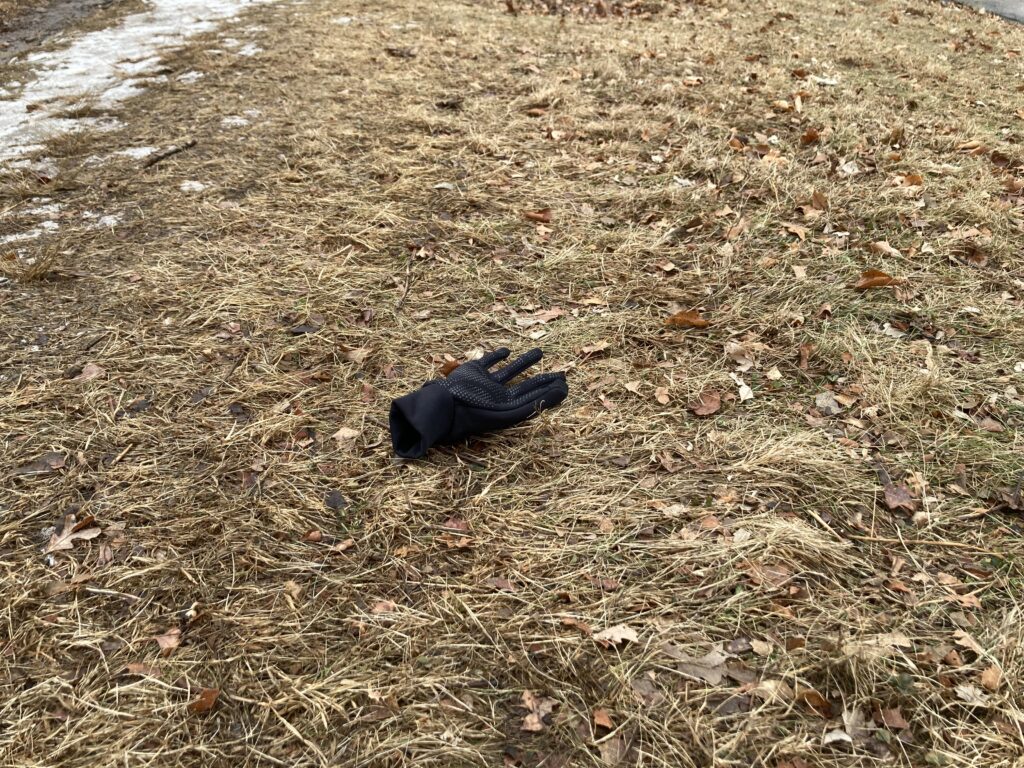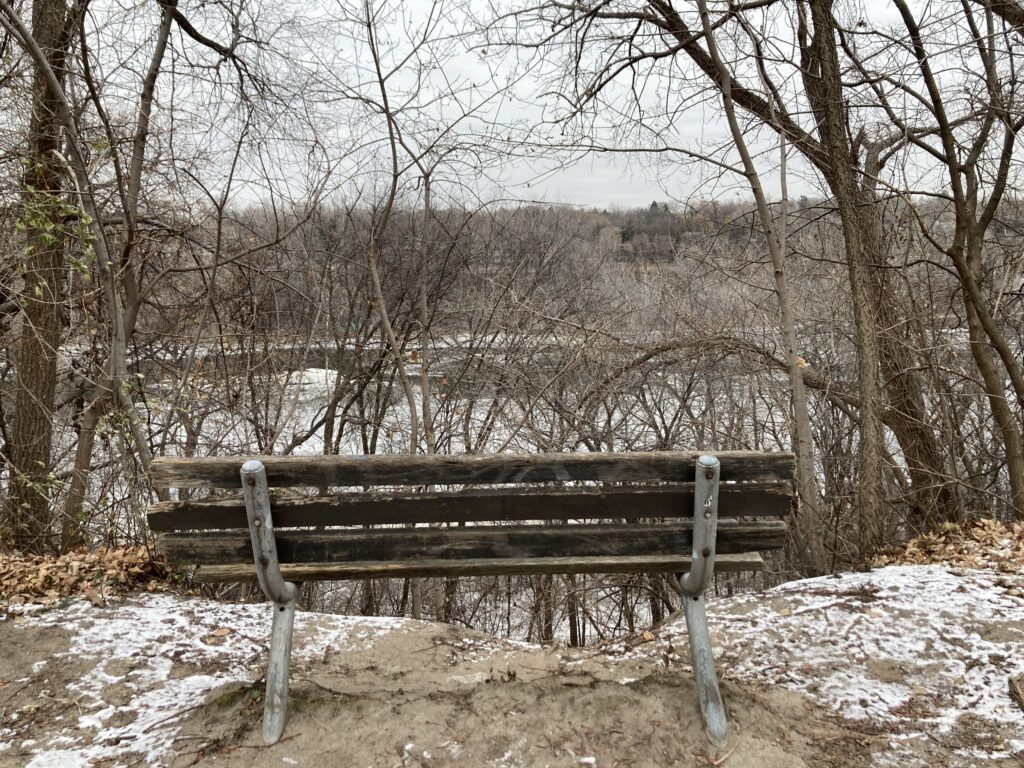4.5 miles
minnehaha falls
20 degrees / feels like 8
Above 0, but still felt cold. It was the wind, swirling softly in all directions, that did it. Ran south to the falls. Wasn’t sure if I’d make it all the way there — it felt difficult — but I did! The creek and the falls were almost all frozen, only a small stream buried under the ice. Looking at the falls from my favorite spot, across the way, it looked like a giant column of ice, which it was.
10 Things
- a strong smell of cigarette smoke near the parking lot
- thin patches of ice on the cobblestone at the park
- kids’ laughter coming from across the road, at the school playground
- my favorite bench, above the edge of the world, was not empty today
- near the bench, the snow where someone had written “DAVIDSON” had melted
- the mottled walking trail at the park — mostly white snow, with grayish asphalt splotching through
- a lone black glove, dropped on the trail
- a dark gray chunk of snow, upright, looking like a squirrel waiting to cross the road
- a few runners, a few walkers, no bikers
- glanced down at the big sledding hill at the park — not much snow and no one sledding down it
I had wanted to thinking about stillness (inspired by an entry from 21 aug 2024) or to chant triple berries but mostly I forgot. I put in a mood playlist: energy at the halfway point and focused on the music, including Britney Spears’ “Work Bitch.” Wow.
before the run
This month, I’ve been reviewing all my entries from 2024 and giving attention to remembering and forgetting and then getting in too deep with thinking and theorizing and organizing ideas around themes. Past Sara — Dr. Sara who is too enamored with theories and ideas and being clever — wants to return. Present Sara needs to figure out some ways to prevent that from happening! Yesterday I decided to take out my scrabble tiles and make anagrams out “remember forget” and “I remember to forget.”
remember forget
bee or germ fret [m]
more bereft germ
beet form merger
forge meter [brm]
frog meter berm
beef rot merger [m]
I Remember to Forget
Got more meter fiber
Orbit form tree gem
bee form griot meter
What anti-theorizing thing can I do today?
A line remembered during my “on this day” practice:
Tell me, how do I steady my gaze
when everything I want is motion?
(Saccadic Masking/ Paige Lewis)
Everything I see is motion or in motion or never not in motion.
Last night we watched a Voyager’s episode in which the crew was experiencing strange symptoms — Captain Janeway had terrible headaches and couldn’t sleep; Chakotay was aging way too fast; Nelix was transforming into another species; and another red shirt went into shock then died. After 7 of 9 shifts into a different phase, she is able to witness what is happening: there are tons of people (human looking) on the ship hovering around the crew members and injecting them with needles. They are experimenting on them in the name of “medical research.” Yikes. Janeway’s headaches are not due to working too hard and not getting enough sleep or exercise, but because they are injecting her with dopamine. They keep increasing the dose to see how much she can take. I said to Scott, can you imagine if our headaches were caused by imaginary creatures messing with us? Then I started to imagine that this was the case. I also started to think about all the things we can’t see that live with us, like mites and bacteria and more. Surprisingly this didn’t freak me out.
Here is a poem I discovered yesterday. I love that first line and what it does as it follows from the title! I found it before I watched the Star Trek Voyager episode, but it is interesting to put them together to think about who/what we live with that we don’t see, or refuse to see:
The Houseguest / Marci Calabretta Cancio-Bello
Forgiveness was sitting in your kitchen when you got home, and now rests elbows on the table to watch you reach for a knife. You scrape the papery skin from a ginger root and slice it into thin coins. You think too hard about which mugs to pull from your cupboard: you might reveal too much; should you offer the one with the uncomfortable handle? Water boils. You divide the ginger evenly into both cups and pour. Spoonful of honey. You stir slowly, eyes down as though you might be able to forget. You stir too long. Forgiveness coughs politely, so you turn, place both mugs on the table, sit. Forgiveness leans forward. You lean back. You have forgotten what it is like to live with someone who eats all your cut watermelon, picks clean the skeletal vine of red grapes, shakes water spots onto your bathroom mirror without wiping them away. What thresholds of welcome have you crossed and recrossed? Most mornings, you listen for the body to move through your house and out the door before leaving your bedroom. Most nights, you ghost around each other without speaking. But now, as the rain drizzles into gloaming, you settle into your chairs, inevitable, a cupful of hesitation finally beginning to loosen your tongues.
And here’s part of a poem I encountered this morning that seems to fit or could be interesting to put beside “The Houseguest” and the Voyager episode:
If/ Imtiaz Dharker
If we could pray. If
we could say we have come here
together, to grow into a tree,
if we could see our blue hands
holding up the moon, and hear
how small the sound is
when it slips through
our fingers into water,
when the meaning of words melts
away and sugarcane speaks
in fields more clearly
than our tongues
That small sound, those blue hands, when words melt away! To give attention, to pray!
Continuing to review past august entries, past Sara wrote this for me, January 2025 Sara:
In January and February, I’ll remember the first orange buoy looking like the moon in an afternoon sky or the glow of orange when the light hits the buoy just right or the gentle rocking of the waves or that satisfied feeling after 90 minutes in the water.
log entry 22 aug 2024
I remember the faintness of that buoy, like the moon in the afternoon visible mostly by my belief that it was there. I also remember swimming that stretch, trying to avoid other swimmers and the ghost vines growing up from the bottom of the lake, seeming extra tall this summer. I’ll remember finally reaching that buoy and rounding it for the start of another loop, unable to see the far shore of a lifeguard or the other 2 orange buoys.
I remember the way the water glowed orange from the reflection of the buoy, or the quick flash of the smallest whisper of an orange dot, or the orange appearing only as a feeling of some disruption in the shoreline scenery — not really seen with my eyes, but registered by my brain — the idea that something was looming ahead.
I don’t remember gentle rocking, but I remember the wild ride of rounding the far green buoy and being pushed around by the water, or how the water seemed so hard to stroke in sometimes.

